Speech Reflections on China and Mining Investment in Australia
I would like to thank CEDA for the invitation to speak here today. Let me also express my gratitude by saying that we continue to learn a lot about the mining industry through our many liaison contacts in Western Australia, and I'm guessing that includes a number of you here in the audience.
I thought this would be a good chance to reflect on two important developments that have stood out in my mind over the past year. One is what's been happening in China. The other, which is closely related, is the change to the outlook for mining investment in Australia. Both have an important bearing on the economy here in Western Australia.
China's Economic Development
China's economic development has been truly remarkable by any measure. For three decades now it has sustained growth at an average of around 10 per cent per annum. China now accounts for a substantial and increasing share of global economic activity. Over the past 10 years, it has almost tripled its share of the global economy to become the second largest economy after the United States.[1] China now uses a large share of the global output of commodities, not only because it's a large economy, but also because it makes relatively intensive use of raw commodities. This reflects the high rate of investment in China as it adds rapidly to its stocks of capital and housing. One driver of this has been the rapid urbanisation of China. This requires the construction of new housing and places of work, as well as transport, communications, power, and water storage and treatment facilities.
China now uses about half of the world's production of iron ore, coking coal and thermal coal. Not surprisingly then, the growth of China has seen the price of Australia's commodity exports rise to unprecedented levels. Accordingly, Australia's terms of trade – the price of our exports relative to the price of our imports – started rising rapidly from the mid 2000s to an historic peak in late 2011 (Graph 1). This has led to a dramatic increase in investment in the resources sector in Australia. Even though the terms of trade have declined since then, they remain well above their level of a decade ago.
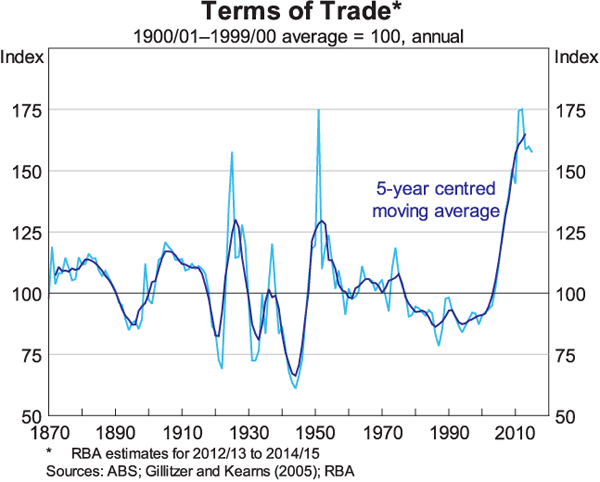
The decline in Australia's terms of trade since late 2011 coincided with a slowing in the pace of China's economic growth and a degree of concern about its near-term outlook. So, for much of the past year we have been looking for signs that China's growth might stabilise. A broad range of indicators suggest that this has now occurred, with economic conditions improving through the second half of 2012, and the national accounts data indicating that growth is running at around 8 per cent in year-ended terms (Graph 2).
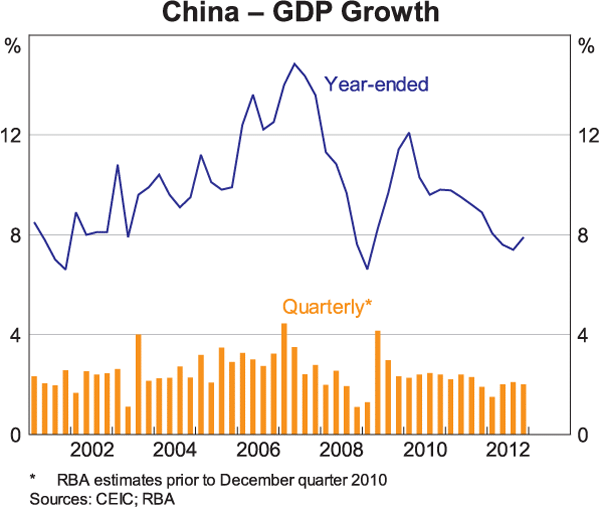
Still, the path of growth in China has not been a smooth one, and China will continue to experience cyclical variation in economic conditions that will need to be carefully managed. Such cycles will have important implications for the prices of commodities because of the size and makeup of China's economy. Changes in commodity prices will in turn influence the outlook for the resources sector in Australia. I'll come back to this issue in a few minutes. For now though, let me turn to the question of what rate of growth China might be able to sustain in the years ahead.
Prospects for Chinese Growth
A gradual slowdown in the trend growth rate of China's economy is to be expected as the process of economic development runs its course. What the path for trend growth will look like though is very hard to know. One way to think about this is to break China's productive capacity into its key elements – its supply of labour, its stock of capital and how productively it can combine these to produce goods and services.
The growth rate of the labour force is perhaps the easier of these elements to forecast because it is driven by slow moving and relatively predictable demographic forces. The working-age population for the country as a whole is expected to peak sometime around the middle of this decade. Absent a significant increase in the rate of labour force participation, including by older workers, this implies less growth in the overall labour force (and eventually some decline). However, perhaps the more important question is what will happen to the growth of the urban workforce. This is critical because urbanisation is the means by which relatively unproductive labour in the rural sector finds its way to more productive activities in urban centres where much of the capital resides. It seems that urbanisation still has a way to go – particularly in the central and western regions of the country (Berkelmans and Wang 2012) (Graph 3). Nevertheless, the pace of urbanisation is likely to slow over time.
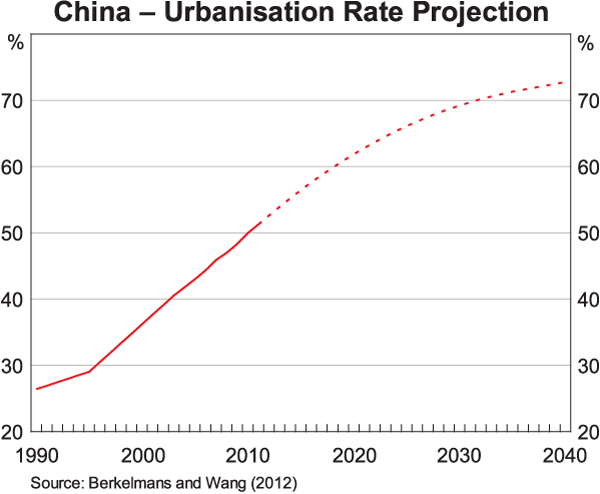
Growth of the capital stock is also likely to slow, in part because there has already been a substantial rise in the capital stock as a share of labour, but also because households are likely to want to consume an increasing share of the country's rising income. Even so, the capital stock per worker is only a small fraction of the US level so there is clearly scope for continued rapid growth in China's capital stock.
Perhaps the greatest source of uncertainty though is the speed with which the level of productivity in China will approach that of the advanced economies. History suggests that as a country draws a little closer to the ‘productivity frontier’ it often becomes more difficult to sustain the same pace of productivity growth. It tends to get a little harder to pursue the reforms that help to drive productivity growth. Those reforms that yield the best returns, and are the easiest to pursue, have already been done; the low hanging fruit has already been picked.[2] In a similar vein, it is easier to emulate – and even improve upon – a range of production processes that have long been in use somewhere else in the world. But it is harder to adopt newer, more advanced, technologies and efficient ways of organising production processes across a wide range of activities, including the provision of services (which account for a substantial share of economic activity in advanced economies). Still, by any reasonable estimate, China remains a long way from the productive frontier. So there is considerable scope for it to continue to catch up with the advanced economies.[3]
A range of estimates for potential output growth have been constructed based on predictions of these three elements of production. The OECD (2012) predict that potential output growth for China will decline from around 10 per cent seen during the 2000s, to 9½ per cent in 2013, and then gradually to 5 per cent by 2025.[4] Last year, the Chinese authorities themselves lowered the official growth target from 8 to 7½ per cent, though the economy had for years consistently overshot even the higher target.
Another way we can try to gauge the potential output of the economy is to look at the relationship between growth and inflation. The idea is that high and rising inflationary pressures tend to follow a period when demand is growing faster than potential output, and vice versa. Over recent years, inflationary pressures have tended to ease in China whenever growth slowed substantially towards 8 per cent or lower, and conversely, around 2010, we saw inflation pressures building when growth was turning up to around 10 per cent or higher (Graph 4). Moreover, this was a growth rate that did not appear to cause undue inflationary pressures in the mid to late 2000s. Taking all of this, and noting also the behaviour of inflation more recently, suggests that potential output growth might be somewhere around the current growth rate of GDP of about 8 per cent
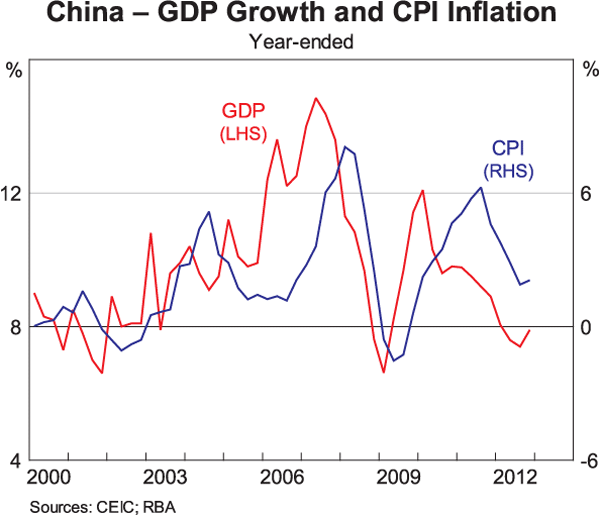
Implications for Demand for Commodities
The prospects for Chinese demand for commodities will depend not just on the growth rate of the economy, but also on the composition of that growth.
As growth in China, and elsewhere in the world, was slowing through 2012, growth in the demand for steel slowed, leading to sharp declines in the spot prices of iron ore and coking coal from July through to early September. But through 2012, the more accommodative stance of financial policies and increased public spending in China have helped to support an increase in the growth rate of investment in infrastructure and dwellings and thereby helped to stabilise growth of the economy overall (Graph 5)
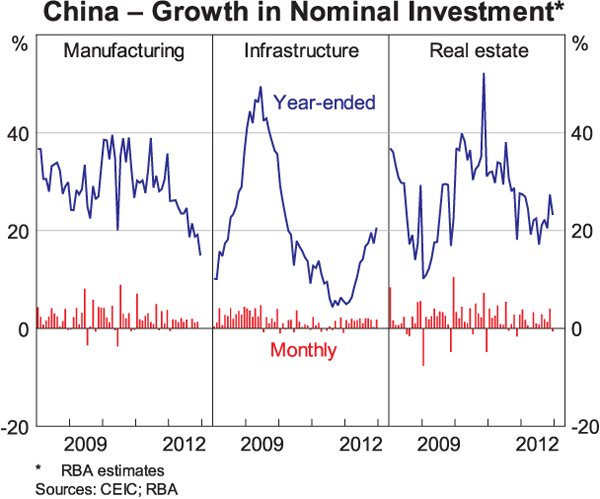
In line with the stronger outlook for infrastructure investment and residential construction, the demand for steel has picked up. The price of steel in China has increased by around 20 per cent since its low point in September last year; the spot price for coking coal has also picked up a little over recent months (Graph 6) The spot price for iron ore has increased by around four times as much from its low point last year. In part, this appears to reflect recent efforts by Chinese steel mills to rebuild their inventories and most observers don't expect iron ore prices to be sustained at current high levels.
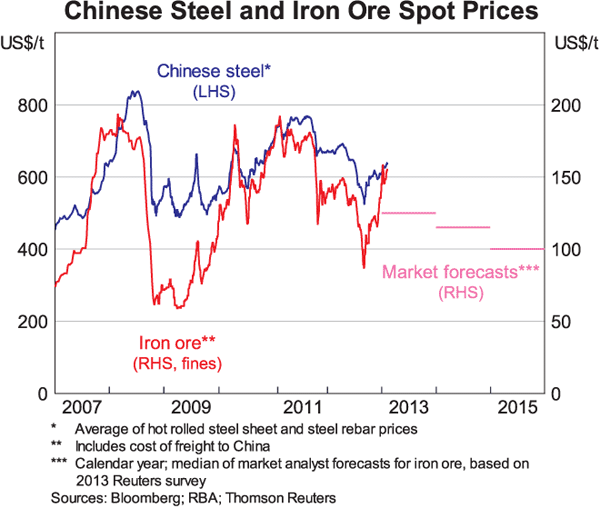
Residential construction has been a key source of demand for steel in the Chinese economy. It currently accounts for around 15 per cent of total steel use. By our estimates, the quantity of steel used in residential construction has roughly doubled over the past eight years. This has been driven by urbanisation and rising incomes, which in turn drive the demand for newer, larger and higher-quality buildings. While we would not expect growth to continue at such a rapid rate, steel use from this sector is not expected to peak for some years.
Of course, we should not overlook other sources of demand for steel. An obvious one is the expansion in rail networks. The demand for steel for this purpose looks likely to continue to grow strongly, with much work yet to be done to develop rail links both between and within cities. Indeed, the Ministry of Railways plans to increase spending in 2013, and maintain this at high levels in 2014 and 2015. This is but one example of the still considerable scope for China to add to its infrastructure, which underpins a range of forecasts for Chinese steel production to continue to grow for another decade and a half.[5]
In short, with a lower rate of trend economic growth, Chinese demand for commodities will grow somewhat less rapidly than in the past. But the expectation is that it will still grow strongly for quite some time. And because the Chinese economy is so much larger now, even a somewhat slower rate of growth represents a large quantity of new demand for raw materials. To help understand the importance of this point, it is worth looking at the example of steel production, which increased by about 9 per cent in 2011. This was equivalent to an extra 58 Mt of steel output. In 2004, the much higher growth rate of about 23 per cent was equivalent to only 50 Mt of extra output.
The Outlook for Mining Investment in Australia
Despite the potential for further growth in the demand for commodities, from China and other developing economies, we expect commodity prices to gradually decline over the next few years. This reflects the extra supply generated by the substantial amount of mining investment underway in Australia, and elsewhere. Nevertheless, commodity prices are expected to remain at what are historically high levels for a considerable period.
The very high price for bulk commodities has helped to drive mining investment in Australia to around 8 per cent of GDP currently, some four times larger than its long-run average. This has led to a significant increase in the share of economic activity accounted for by the resource sector since the mid 2000s. While the share of the workforce directly employed in the business of mining has doubled since then, it remains relatively modest (at around 2½ per cent). However, there has been a substantial spillover of activity to other parts of the economy, including to a wide range of businesses that help mining companies to extract resources or to build up their capital infrastructure. The Bank will soon publish some research providing estimates of the contribution of mining and mining-related activity to GDP and employment (Rayner and Bishop, forthcoming). This work suggests that the resource sector as a whole currently accounts for around 18 per cent of GDP, with about a third of this owing to resource-related activities. Similarly, the resource sector accounts for almost 10 per cent of employment, with a bit more than two-thirds of this owing to resource-related activities.[6]
The sharp fall in bulk commodity prices from the middle of last year prompted mining firms to reassess their expenditure and the viability of some investment projects that had been under consideration. Some uncommitted projects were deferred. Much exploration activity was curtailed. Spending on machinery and equipment was scaled back significantly. And some existing operations were shut down, primarily smaller, older, higher-cost coal mines. This turnaround in sentiment came about in part because lower prices reduced cash flows and external financing became harder to come by, making it more difficult to finance resource investment. The recent sharp rise in iron ore prices, as best we can tell, has not yet made much of a difference to investment plans, presumably because the price is not expected to stay at its current high level.
As you are all no doubt well aware, a large share of mining investment currently underway in Australia is in the liquefied natural gas (LNG) sector. LNG projects require significant investment over a 3–5 year period, and a very long period of production to recoup the initial investment. As a result, commitments to invest in these projects are made on the basis of long-term contracts signed with the buyers of LNG (with those buyers often even taking an equity stake in the project). For this reason, investment in LNG has been resilient to the significant changes in sentiment affecting other parts of the resource sector.
Of greater concern for LNG projects are rising costs, which reduce the returns on projects underway and reduce the prospects of future expansions. Some of what has been reported as higher costs by mining companies reflects the appreciation of the Australian dollar. Some companies had budgeted for these projects in US dollar terms at a lower exchange rate than we face currently. Still, there's no denying that costs have increased over time even in Australian dollar terms.
We can try to look at some data from the Australian Bureau of Statistics to gain some understanding of changes in costs over time, although it will not pick up important differences across different projects in different industries. There is evidence in the aggregate data of higher inflation of wages in the mining industry, and across Western Australia more generally (Graph 7) While the growth of these wages has picked up a little recently, this is unlikely to be sufficient to account for the magnitude of some of the cost overruns being reported. Nevertheless, the level of wages in the mining industry remains relatively high, though this reflects the relatively high capital-to-labour ratio in this industry (Graph 8)
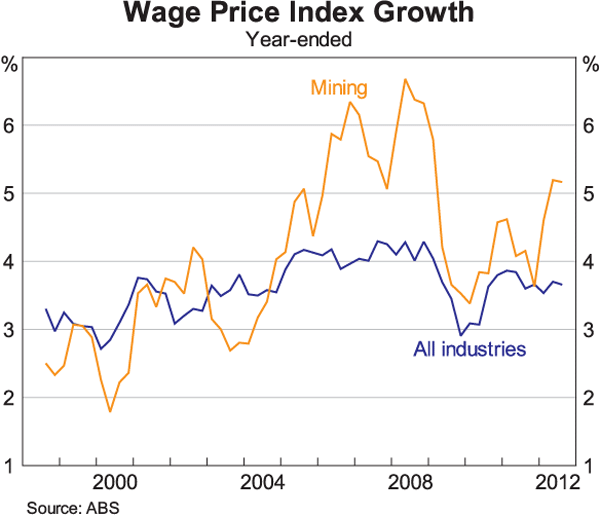
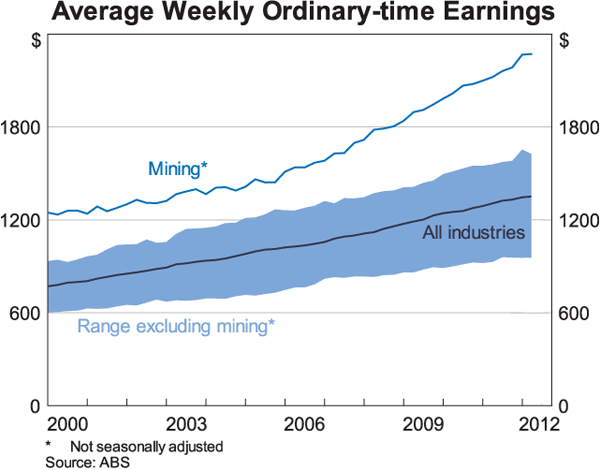
One plausible explanation for at least some of the cost overruns is logistical problems affecting a number of projects. It seems that the engineering challenges for some projects are even more complex than initially thought. There are cases of projects taking longer to complete, and/or requiring more investment to bring them to fruition. In other cases, the scope of the project may have changed. All of these things can alter the profile for mining investment by affecting both the timing and the amount of expenditure.
So, what's been the net effect on the outlook for mining investment overall of these changes in sentiment, timing, scope and costs? As best we can tell, mining investment now appears likely to reach a peak a bit earlier – sometime this year – and at a lower level – of around 8 per cent of GDP – than we had earlier expected (Graph 9). This is broadly consistent with the latest ABS survey of firms' capital expenditure plans, which shows that in the mining sector, the growth of nominal investment in 2012/13 was revised from around 40 per cent to 20 per cent from the June quarter 2012 survey to the September quarter release (after adjusting for the realisation ratio).
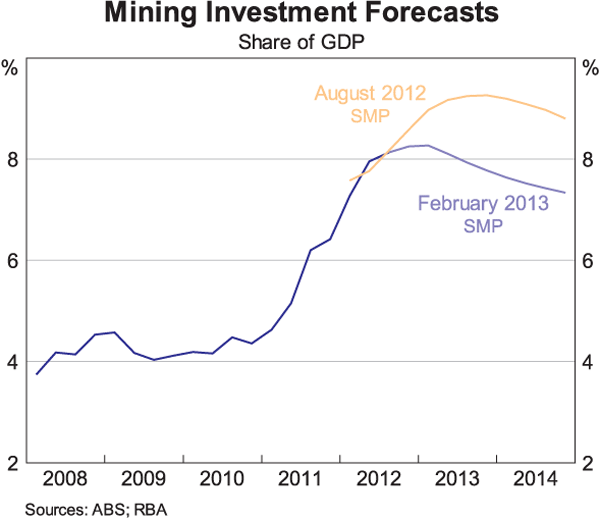
Like all forecasts, the profile for mining investment is subject to considerable uncertainty. We cannot be sure about when the peak will occur, nor can we be sure about the pace at which mining investment will decline as a share of GDP. This will depend not just on the outcome of decisions regarding uncommitted projects, but also the rate of progress on existing projects and the extent and nature of any further cost overruns.
Notwithstanding this uncertainty, there is still a large amount of work in the pipeline, and so mining investment is likely to remain quite elevated for a time. And as mining investment tails away, we'll increasingly move into the operational phase of the mining boom. This is when exports will increase significantly in response to all of the investment that's been undertaken. Strong growth of iron ore, coal and LNG exports has been evident for some time now, but further strong growth is anticipated, particularly for LNG, which is expected to grow much more rapidly starting from around 2015 (Graph 10)
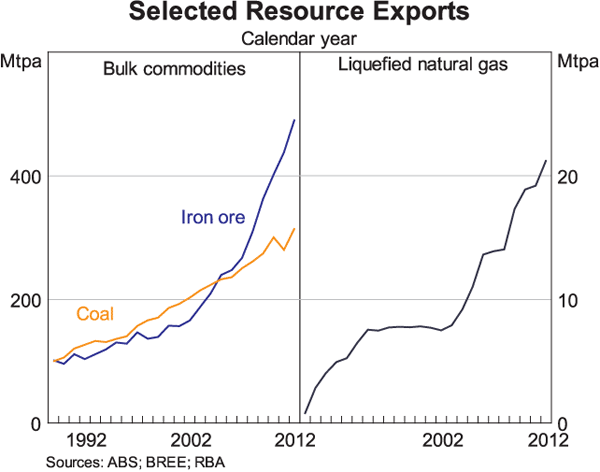
The revised outlook for mining investment and our predictions for bulk commodity exports have been incorporated into our latest forecasts for economic growth in the Statement of Monetary Policy published last week. Our expectation is that growth of economic activity will be a little below trend over 2013 before picking up a little in 2014. These forecasts assume that growth from sources outside of the resource sector picks up gradually, so we'll be looking closely for signs of this over the months ahead. Looking further ahead, as I have suggested in my remarks about China's economy, Australia is well placed to benefit from the ongoing development there as well as in other developing economies in the region.
Endnotes
I would like to thank James Bishop and Tom Cusbert for valuable assistance in the preparation of this talk. [*]
Figures are projections for 2012, based on market exchange rates, from the IMF World Economic Outlook, October 2012. [1]
Lardy (2012) and the World Bank (2012) emphasise further reforms of banking and financial markets more generally, hukou reform and liberalisation of energy prices. [2]
IMF (2012) data imply that output per worker is only about 15 per cent of that in the United States. Also, GDP (PPP) per capita for China is one-quarter of the average of advanced economies (IMF 2012). [3]
Other estimates are broadly consistent with these, although the estimates in Lee and Hong (2010) are lower with a 2011–2020 average of 6 per cent in the baseline scenario and 7 per cent in a scenario with more substantial reform. [4]
Rio Tinto and UN projections suggest a peak in 2030. Projections by the Bureau of Resources and Energy Economics (BREE) show demand increasing through to 2025. [5]
The estimates for GDP and employment shares of the resource sector as a whole in the mid 2000s are 10 per cent and almost 5 per cent, respectively. [6]
References
Berkelmans L and H Wang (2012), ‘Chinese Urban Residential Construction to 2040’, RBA Research Discussion Paper No 2012-04.
Bureau of Resources and Energy Economics (2012), Australian Bulk Commodity Exports and Infrastructure – Outlook to 2025. Available at <http://www.bree.gov.au/documents/publications/_other/Export-Infrastructure-Report.pdf>.
IMF (2012), World Economic Outlook, October. Available at <http://www.imf.org/external/pubs/ft/weo/2012/02/weodata/index.aspx>.
Lee JW and K Hong (2010), ‘Economic Growth in Asia: Determinants and Prospects’, ADB Economics Working Paper Series No 220. Available at <http://www.adb.org/sites/default/files/pub/2010/economics-wp220.pdf>.
Lardy NR (2012), Sustaining China's Economic Growth after the Global Financial Crisis, Peterson Institute for International Economics, Washington DC.
OECD (2012), ‘Medium and Long-term Scenarios for Global Growth and Imbalances’, in OECD Economic Outlook, Vol 2012/1, OECD Publishing, pp 191–224. Available at <http://www.oecd.org/berlin/50405107.pdf>.
Rayner V and J Bishop (forthcoming), ‘Industry Dimensions of the Resource Boom: An Input-Output Analysis’, RBA Research Discussion Paper No 2013-02
Rio Tinto (2012), ‘Outlook for Metals and Minerals: Half Year Results 2012’, 8 August. Available at <http://www.riotinto.com/documents/FinancialResults/120808_Outlook_for_Metals_and_Minerals_-_half_year_results_2012.pdf>.
World Bank (2012), China 2030: Building a Modern, Harmonious, and Creative High-Income Society, Conference Edition, The World Bank, Washington DC. Available at <http://www.worldbank.org/content/dam/Worldbank/document/China-2030-complete.pdf>.
United Nations Development Programme: China (2010), China and a Sustainable Future: Towards a Low Carbon Economy and Society, China Translation and Publishing Corporation, Beijing. Available at <http://planipolis.iiep.unesco.org/upload/China/China_HDR_2009_2010.pdf>.
